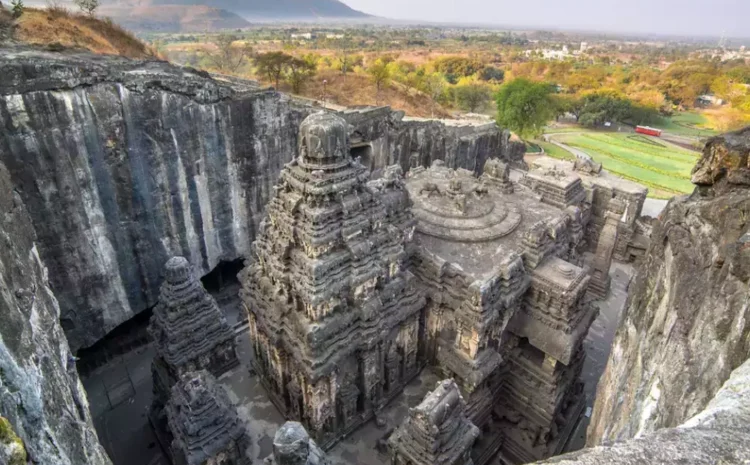
Ajanta and Ellora Caves: A Testament to India’s Artistic and Spiritual Heritage
Ajanta and Ellora Caves, located in the state of Maharashtra, India, are among the most remarkable rock-cut cave complexes in the world. These caves are not just architectural marvels but also a testament to India’s rich cultural, artistic, and spiritual heritage. A UNESCO World Heritage Site, these caves attract historians, archaeologists, and tourists from across the globe. The Ajanta Caves are renowned for their exquisite Buddhist paintings and sculptures, while the Ellora Caves showcase a blend of Hindu, Jain, and Buddhist architectural brilliance.
Ajanta Caves: The Epitome of Buddhist Art
Ajanta Caves, nestled in the Sahyadri Hills, date back to around the 2nd century BCE to the 6th century CE. These 30 rock-cut caves were primarily used as a retreat for Buddhist monks and served as a center for learning and meditation. The caves contain stunning murals and frescoes that depict the life and teachings of Buddha.
Key Highlights of Ajanta Caves
- Exquisite Murals and Frescoes – The paintings in Ajanta are considered masterpieces of ancient Indian art. The most famous ones include the depiction of the Jataka tales, which narrate the previous lives of Buddha.
- Cave 1 and Cave 2 – These caves house some of the best-preserved murals, including the famous Padmapani and Vajrapani Bodhisattva paintings.
- Chaitya and Viharas – The caves are divided into two types: Chaityas (prayer halls) and Viharas (monasteries). Cave 26 features a magnificent reclining Buddha, symbolizing his attainment of Nirvana.
The Ajanta Caves remained hidden for centuries until they were rediscovered in 1819 by a British officer, John Smith. Their rediscovery marked a significant moment in Indian archaeology, unveiling the grandeur of ancient Indian artistry.
Ellora Caves: A Confluence of Religions
Unlike Ajanta, which is exclusively Buddhist, the Ellora Caves represent the harmonious coexistence of Hinduism, Buddhism, and Jainism. Dating from the 6th to 10th century CE, these caves are a marvel of rock-cut architecture, extending over 2 km.
Key Highlights of Ellora Caves
- Kailasa Temple (Cave 16) – One of the most astounding features of Ellora, this temple is dedicated to Lord Shiva and is the largest rock-cut monolithic structure in the world. Carved from a single rock, it represents Mount Kailash and is an engineering wonder.
- Buddhist Caves (Caves 1-12) – These caves contain monasteries, prayer halls, and intricate carvings of Buddha and Bodhisattvas. Cave 10, known as the Vishvakarma Cave, features a massive seated Buddha.
- Hindu Caves (Caves 13-29) – Apart from the Kailasa Temple, these caves depict Hindu deities, mythological scenes, and stories from the Ramayana and Mahabharata.
- Jain Caves (Caves 30-34) – These caves highlight the Jain philosophy and include intricate sculptures of Tirthankaras. The Indra Sabha in Cave 32 is one of the most impressive Jain structures at Ellora.
Architectural Brilliance and Significance
The craftsmanship of these caves is unparalleled. The artists and sculptors of Ajanta and Ellora used simple tools like chisels and hammers to create intricate carvings, detailed frescoes, and massive temple structures. The method of excavation, particularly in Kailasa Temple, where the rock was carved top-down, showcases an advanced understanding of engineering and design.
Tourism and Conservation
Ajanta and Ellora Caves remain major tourist attractions, drawing visitors from around the world. The Archaeological Survey of India (ASI) has taken several measures to preserve these sites, including restricting flash photography, monitoring humidity levels, and promoting sustainable tourism practices.
Conclusion
Ajanta and Ellora Caves are not merely historical sites but living symbols of India’s artistic ingenuity and religious tolerance. Whether it is the serene Buddhist murals of Ajanta or the architectural marvel of Kailasa Temple at Ellora, these caves stand as a timeless legacy of India’s golden past. Visiting these caves is like stepping into a world where art, spirituality, and history intertwine, making them a must-visit destination for history enthusiasts and cultural explorers alike.